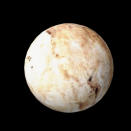|
The Planets in our Solar SystemDeveloper: Kristin D'Ambrisi |
|---|
 Mercury | Mercury is the closest planet to the sun. One year lasts 88 Earth-days and one day lasts 176 Earth-days. Its diameter is 4,878 km and it is about 57,910,000 km from the sun. Its temperature ranges from -180° to +430° Celsius. Mercury's surface is full of craters because of impacts from debris. It is difficult to spot Mercury through a telescope because it is so small and close to the sun. |
 Venus | Venus is the second planet from the sun and one of Earth's neighbors. It is known as Earth's "sister planet" because they are so similar in size. One year lasts 224 Earth-days and one day lasts 117 Earth-days. Its diameter is 12,103 km and it is about 108,200,000 km from the sun. Its temperature is 465° Celsius. Venus is covered with a thick layer of clouds and is the hottest planet. Venus is easy to spot after sunset or before sunrise and looks like a very bright star. |
 Earth | Earth is the third planet from the sun and the only one known to have life on it. One year is 365 days long and one day is 24 hours long. It's diameter is 12,756 km and it is 149,600,000 km from the sun. It's temperature ranges from -70° to +55° Celsius. This is an active planet with an active, changing surface of water, land, active volcanoes, and earthquakes. Earth's nickname is "The Blue Planet" because of how it is seen from space being 2/3 covered by water. |
 Mars | Mars is the fourth planet from the sun and one of Earth's neighbors. It is known the "Red Planet" because of it's color. One year lasts about 687 Earth-days and one day is a little over 24 hours long. Its diameter is 6,786 km and it is 227,940,000 km from the sun. Its temperature ranges from -120° to +25° Celsius. Mars has mountains, volcanoes, deserts, and canyons. Mars is easy to spot at night because it is bright and red. Currently, Mars is being explored by rovers from NASA. |
 Jupiter | Jupiter is the fifth planet from the sun. One year lasts almost 12 Earth-years and it's is about 10 hours long. It is so large that it is bigger than all of the other planets combined. Its diameter is 142,984 km and it is 778,330,000 km from the sun. Its temperature is about -150° Celsius. Jupiter can easily be seen in the night sky because it is brighter than any star. |
 Saturn | Saturn is the sixth planet from the sun. One year lasts almost 30 Earth-years and one day is about 12 hours long. It's diameter is 120,536 km and it is 1,426,980,000 km from the sun. Its temperature is about -180° Celsius. It is known as the planet with the rings. The rings are made of millions of various sized chunks of ice and can be seen with a small telescope. |
 Uranus | Uranus is the seventh planet from the sun. One year lasts 84 Earth-years and one day is about 17 hours long. Its diameter is 51,118 km and it is 2,870,990,000 km from the sun. Its temperature is -210° Celsius. This planet is actually tipped and orbits the sun on its side. It is easy to see this by looking at its rings. Uranus can be seen with binoculars or a telescope and may look like a star because of its distance from Earth. |
 Neptune | Neptune is the eighth planet from the sun. One year lasts about 165 Earth-years and one day is about 16 hours long. Its diameter is 49,528 km and it is 4,497,070,000 km from the sun. Its temperature is -210° Celsius. The surface is mostly gas and water. Uranus also has a few rings. With binoculars, this planet will appear as a faint, bluish star and is easier to see with a telescope. |
 Pluto | Pluto is the ninth planet from the sun, and the farthest. One year lasts almost 249 Earth-years and one day lasts about 6 Earth-days. Its diameter is 2.284 km and it is 5,913,520,000 km from the sun. Its temperature is -220° Celsius. This planet has an elongated, elliptical orbit. Its surface is mostly ice. |
|
Test what you learned! Check out a game created by this site's developer! When finished with the game, press the back button to return to this page. | |
| Source: Couper, Heather, and Nigel Henbest. The Space Atlas. New York: Harcourt, 1992. | |